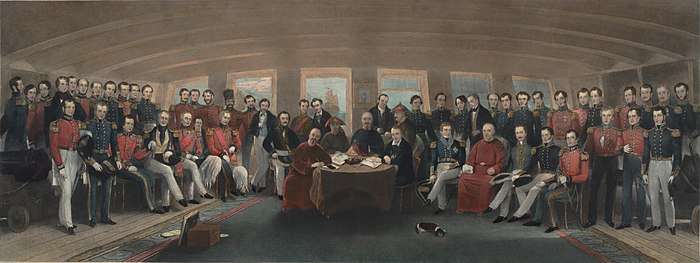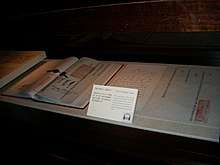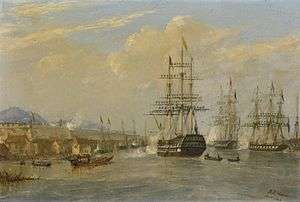Treaty of Nanking
The Treaty of Nanking (Nanjing) was a peace treaty which ended the First Opium War (1839–1842) between the United Kingdom and China on 29 August 1842. It was the first of what the Chinese later called the unequal treaties.[2]
Long name:
| |
|---|---|
 Signing of the treaty on board HMS Cornwallis | |
| Signed | 29 August 1842 |
| Effective | 26 June 1843 |
| Condition | Exchange of ratifications |
| Parties | |
| Languages | English and Chinese |
| Treaty of Nanking | |||||||||||||||
|---|---|---|---|---|---|---|---|---|---|---|---|---|---|---|---|
| Traditional Chinese | 南京條約 | ||||||||||||||
| Simplified Chinese | 南京条约 | ||||||||||||||
| |||||||||||||||
| This article is part of a series on the |
| History of Hong Kong |
|---|
 |
| Timeline |
| By topic |
|
In the wake of China's military defeat, with British warships poised to attack Nanking, British and Chinese officials negotiated on board HMS Cornwallis anchored at the city. On 29 August, British representative Sir Henry Pottinger and Qing representatives Qiying, Yilibu, and Niu Jian signed the treaty, which consisted of thirteen articles. The treaty was ratified by the Daoguang Emperor on 27 October and Queen Victoria on 28 December. Ratification was exchanged in Hong Kong on 26 June 1843. A copy of the treaty is kept by the British government while another copy is kept by the Ministry of Foreign Affairs of Republic of China at the National Palace Museum in Taipei, Taiwan.
Background
Britain was importing and selling large quantities of opium to China because it was very profitable and helped balance Britain's trade deficit resulting from its importation of Chinese goods, such as tea. Britain forced peasants in its colony, India, to grow opium poppies so it could sell the opium in China, although the importation and sale of opium were illegal under Chinese law. When a Chinese government official seized British opium cargo in 1841, Britain declared what became known as the first Opium War. Britain won the war and was in a position to impose on the vanquished Chinese a one-sided treaty with onerous treaty obligations.[3]
The first working draft for articles of a treaty was prepared at the Foreign Office in London in February 1840. The Foreign Office was aware that preparing a treaty containing Chinese and English characters would need special consideration. Given the distance separating the countries, it was realised that some flexibility and a departure from established procedure in preparing treaties might be required.[4]
Terms

Foreign trade
The fundamental purpose of the treaty was to change the framework of foreign trade imposed by the Canton System, which had been in force since 1760. Under Article V, the treaty abolished the former monopoly of the Cohong and their Thirteen Factories in Canton. Four additional "treaty ports" opened for foreign trade alongside Canton (Shameen Island from 1859 until 1943): Amoy (Xiamen until 1930), Foochowfoo (Fuzhou), Ningpo (Ningbo) and Shanghai (until 1943),[5][6] where foreign merchants were to be allowed to trade with anyone they wished. Britain also gained the right to send consuls to the treaty ports, which were given the right to communicate directly with local Chinese officials (Article II). The treaty stipulated that trade in the treaty ports should be subject to fixed tariffs, which were to be agreed upon between the British and the Qing governments (Article X).[7]
Reparations and demobilisation
The Qing government was obliged to pay the British government six million silver dollars for the opium that had been confiscated by Lin Zexu in 1839 (Article IV), 3 million dollars in compensation for debts that the Hong merchants in Canton owed British merchants (Article V), and a further 12 million dollars in war reparations for the cost of the war (Article VI). The total sum of 21 million dollars was to be paid in instalments over three years and the Qing government would be charged an annual interest rate of 5 percent for the money that was not paid in a timely manner (Article VII).[7]
The Qing government undertook to release all British prisoners of war (Article VIII), and to give a general amnesty to all Chinese subjects who had cooperated with the British during the war (Article IX).[7]
The British on their part, undertook to withdraw all of their troops from Nanking, the Grand Canal and the military post at Zhenhai, as well as not to interfere with China trade generally, after the emperor had given his assent to the treaty and the first instalment of money had been received (Article XII). British troops would remain in Gulangyu and Zhaobaoshan until the Qing government had paid reparations in full (Article XII).[7]
Cession of Hong Kong
In 1841, a rough outline for a treaty was sent for the guidance of Plenipotentiary Charles Elliot. It had a blank after the words "the cession of the islands of". Pottinger sent this old draft treaty on shore, with the letter s struck out of islands and the words Hong Kong placed after it.[8] Robert Montgomery Martin, treasurer of Hong Kong, wrote in an official report:
The terms of peace having been read, Elepoo the senior commissioner paused, expecting something more, and at length said "is that all?" Mr. Morrison enquired of Lieutenant-colonel Malcolm [Pottinger's secretary] if there was anything else, and being answered in the negative, Elepoo immediately and with great tact closed the negotiation by saying, "all shall be granted—it is settled—it is finished."[8]
The Qing government agreed to make Hong Kong Island a crown colony, ceding it to the British Queen, Queen Victoria, "in perpetuity" (常 遠, Cháng yuǎn, in the Chinese version of the treaty), to provide British traders with a harbour where they could "careen and refit their ships and keep stores for that purpose" (Article III). Pottinger was later appointed the first governor of Hong Kong.
In 1860, the colony was extended with the addition of the Kowloon peninsula[9] and in 1898, the Second Convention of Peking further expanded the colony with the 99-year lease of the New Territories.[10] In 1984, the governments of the United Kingdom and the People's Republic of China (PRC) concluded the Sino-British Joint Declaration on the Question of Hong Kong, under which the sovereignty of the leased territories, together with Hong Kong Island and Kowloon (south of Boundary Street) ceded under the Convention of Peking (1860), was transferred to the PRC on 1 July 1997.[11]
Aftermath

The treaty was sealed by interpreter John Robert Morrison for the British and Wang Tajin for the Chinese. Harry Parkes, who was a student of Chinese under Morrison, gave his account of the ceremony:
There were four copies of the Treaty signed and sealed. They were bound in worked yellow silk, one Treaty in English and the same in Chinese stitched and bound together formed a copy. This being finished they all came out of the after-cabin and sat down to tiffin, and the different officers seated themselves all round the table, making plenty of guests. Almost directly after the Treaty was signed, a yellow flag for China at the main and a Union Jack for England at the mizen were hoisted, and at the same time a royal salute of twenty-one guns was fired.[12]
The Daoguang Emperor gave his assent for the treaty on 8 September.[4] After his assent arrived in Nanking on 15 September, Pottinger's secretary George Alexander Malcolm was dispatched on board the steamer Auckland the next morning to the Court of St James's with a copy for ratification by Queen Victoria.[13] The emperor ratified the treaty on 27 October and Queen Victoria added her written assent on 28 December. Ratification was exchanged in Hong Kong on 26 June 1843.[4]
Pottinger wrote in a letter to the Earl of Aberdeen the following year that at a feast with Qiying celebrating the ratification, Qiying insisted they ceremonially exchange miniature portraits of each member of each other's families. Upon receiving a miniature portrait of Pottinger's wife, Pottinger wrote that Qiying "placed [the miniature] on his head—which I am told is the highest token of respect and friendship—filled a glass of wine, held the picture in front of his face, muttered some words in a low voice, drank the wine, again placed the picture on his head and then sat down" to complete the ceremony of long-term amity between the two families and the two peoples.[14] This extravagant display has been analyzed as showing an "erotically charged ... reciprocity [in] this symbolic gesture of swapping images of wives.[15]
Because of the brevity of the Treaty of Nanking and its terms being phrased only as general stipulations, the British and Chinese representatives agreed that a supplementary treaty should be concluded to establish more detailed regulations for relations. On 3 October 1843, the parties concluded the supplementary Treaty of the Bogue at the Bocca Tigris outside Canton.
Nevertheless, the treaties of 1842–43 left several unsettled issues. In particular they did not resolve the status of the opium traffic in favour of the British Empire. Although the Treaty of Wanghia with the Americans in 1844 explicitly banned Americans from selling opium, the trade continued as both the British and American merchants were only subject to the legal control of their permissive consuls. The opium traffic was later legalised in the Treaties of Tianjin, which China concluded after the Second Opium War resulted in another defeat for the Qing dynasty.
The Nanking Treaty ended the old Canton System and created a new disadvantageous framework for China's foreign relations and overseas trade, which would last for almost a hundred years. From the Chinese perspective, the most injurious terms were the fixed trade tariff, extraterritoriality, and the most favoured nation provisions. These were conceded partly out of expediency and partly because Qing officials did not yet know of international law or understand the long-term consequences, and also negotiated after military defeats. The tariff fixed at 5% was higher than before while the concept of extraterritoriality seemed to put the burden on foreigners to police themselves. In addition, the most favoured nation treatment appeared to set the foreigners one against the others. Although China regained tariff autonomy in the 1920s, extraterritoriality was not formally abolished until the 1943 Sino-British Treaty for the Relinquishment of Extra-Territorial Rights in China.[16] Not until the retrocession of Hong Kong in 1997 did China revert the last of the onerous impositions of the Western powers.
See also
- Western imperialism in Asia
- History of Hong Kong
- Anglo-Chinese relations
- Henry Collen (photographed the treaty)
Notes
- Mayers, William Frederick (1902). Treaties Between the Empire of China and Foreign Powers (4th ed.). Shanghai: North-China HeraTreaty of London (1871)ld. p. 1.
- Hoe, Susanna; Roebuck, Derek (1999). The Taking of Hong Kong: Charles and Clara Elliot in China Waters. Routledge. p. 203. ISBN 0-7007-1145-7.
- Ha-Joon Chang, "Bad Samaritans: The Myth of Free Trade and the Secret History of Capitalism," (New York: Bloomsbury Publishing, 2008), p. 24
- Wood, R. Derek (May 1996). "The Treaty of Nanking: Form and the Foreign Office, 1842–43". The Journal of Imperial and Commonwealth History 24 (2): 181–196.
- John Darwin, After Tamerlane: The Global History of Empire, p. 271. (London: Allen Lane, 2007) "Under the 1842 Treaty of Nanking, five 'treaty ports' were opened to Western trade, Hong Kong island was ceded to the British, the Europeans were allowed to station consuls in the open ports, and the old Canton system was replaced by the freedom to trade and the promise that no more than 5 per cent duty would be charged on foreign imports."
- John Darwin, After Tamerlane: The Global History of Empire, p. 431. (London: Allen Lane, 2007) "In 1943 the remnants of China's unequal treaties were at last swept away when the British abandoned their surviving privileges there as so much useless lumber."
- Treaty of Nanking
- Martin, Robert Montgomery (1847). China: Political, Commercial, and Social; In an Official Report to Her Majesty's Government. Volume 2. London: James Madden. p. 84.
- Endacott, G. B.; Carroll, John M. (2005) [1962]. A biographical sketch-book of early Hong Kong. Hong Kong University Press. ISBN 978-962-209-742-1.
- "Lessons in History". National Palace Museum (Taipei). 9 August 2011. Retrieved 27 August 2018.
- Constitutional and Mainland Affairs Bureau, The Government of the HKSAR. "The Joint Declaration" and following pages, 1 July 2007.
- Lane-Poole, Stanley (1894). The Life of Sir Harry Parkes. Volume 1. London: Macmillan and Co. pp. 47–48.
- The Chinese Repository. Volume 11. Canton. 1842. p. 680.
- Koon, Yeewan (2012). "The Face of Diplomacy in 19th-Century China: Qiying's Portrait Gifts". In Johnson, Kendall (ed.). Narratives of Free Trade: The Commercial Cultures of Early US-China Relations. Hong Kong University Press. pp. 131–148.
- Koon, Yeewan (2012). "The Face of Diplomacy in 19th-Century China: Qiying's Portrait Gifts". In Johnson, Kendall (ed.). Narratives of Free Trade: The Commercial Cultures of Early US-China Relations. Hong Kong University Press. pp. 139–140.
- Hsu, The Rise of Modern China: 190–92.
References
| Wikisource has original text related to this article: |
- Fairbank, John King. Trade and Diplomacy on the China Coast: The Opening of the Treaty Ports, 1842–1854. 2 vols. Cambridge, MA: Harvard University Press, 1953.
- Têng Ssu-yü. Chang Hsi and the Treaty of Nanking, 1842. Chicago: University of Chicago Press, 1944.
- R. Derek Wood, 'The Treaty of Nanking: Form and the Foreign Office, 1842–1843', Journal of Imperial and Commonwealth History (London) 24 (May 1996), 181–196.
External links
- Original Treaty of Nanking in English-Chinese from National Palace Museum, Taipei
- English Text in London Gazette (Differs in some respects from Chinese text)